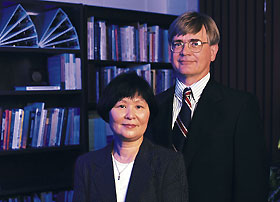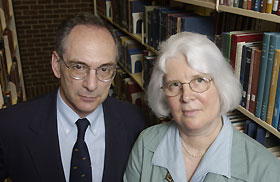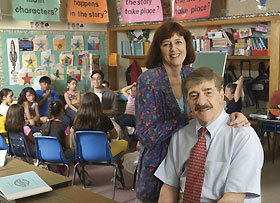|
This is an archived article.
For the latest news, go to the Advance Homepage
For more archives, go to the Advance Archive/Search Page. |
||||||||
|
Faculty Couples Blend Ideas, Respect
Being "married to your work" is an expression that aptly describes many faculty members at UConn, but for some it has special significance. In a variety of fields, there are professors whose spouses are not only on the faculty but are also close research collaborators. They may share students, grants, and the authorship of papers and books; teach together; work in the lab or archives together; and go home together. The benefits are many, they say, for their own work and for the University. "Two minds are better than one. You get almost three scientists this way," says Rachel O'Neill, who, like her husband, Michael O'Neill, is an assistant professor of molecular and cell biology. They share a National Science Foundation grant, but they also bring in grants on their own - she is in the third year of an NSF Career Grant, and he has research support from the National Institutes of Health (NIH). "Often people don't recognize the contributions of couples as professional collaborators," says Xiangzhong (Jerry) Yang, professor of animal science and director of the Center for Regenerative Biology, who collaborates with his wife, X. Cindy Tian, an assistant professor of animal science, in the study of animal cloning.
Her background in molecular biology and genetic analysis and his in embryology provide a powerful combination of basic and applied research skills, he says. That has resulted in breakthrough papers in Nature, Nature Genetics, and Proceedings of the National Academy of Sciences in recent years, as well as the nation's first successful cloning of a farm animal from an adult animal - the calf, Amy.
Mutual Respect
"We really don't compete - we support each other. If you're competitive, it would be difficult," says Michie Hesselbrock, who collaborates with her husband, Victor Hesselbrock, on alcoholism research. She is the Zachs Professor and director of the Ph.D. program at the School of Social Work, and he holds the Physician Health Services Chair in Addiction Studies and is director of the Alcohol Research Center in the Department of Psychiatry at the UConn Health Center. The downside of working together, some couples say, is that they are always working - weekends and nights as well as the regular work day. As one half of a team says, if they didn't share research problems, they'd probably take a break and do something together outside of work. But the excitement of the research seems to compensate for the relentless focus. "One of the pleasures of working together is, you keep finding new things and sharing them with each other," says Irene Q. Brown, associate professor emerita of family studies, who recently co-authored the book, The Hanging of Ephraim Wheeler: A Story of Rape, Incest and Justice in Early America, with her husband, Richard D. Brown, Board of Trustees Distinguished Professor of History and director of the University's Humanities Institute. Richard Brown first found a reference to Wheeler's 1806 execution in a footnote when he was looking for something else. Wheeler was convicted of raping his daughter, and the execution was attended by 5,000 people, or one-sixth of the population of Berkshire County, Mass. Intrigued by the story, Richard discussed his finding with Irene. Together, they developed an Honors Program undergraduate research course out of it, which they team-taught twice. Piecing together Wheeler's story - which involved issues of family violence, race, and the role of morality and religion in the affairs of state - absorbed them both. Richard Brown was awarded a Guggenheim fellowship to continue the work, and their research led to a book published in April by Harvard University Press that was termed "very insightful" by a reviewer in the Times Literary Supplement of London.
The collaboration was their first, even though they have been married for more than 40 years and have had parallel careers as historians. Historians seldom collaborate, unlike scientists or social scientists, they say. "I don't know if it would have gone as smoothly when we were just starting out," says Irene. They both were graduate students in history at Harvard when they married in 1962. And both were awarded Fulbright scholarships to study in France: Irene conducted archival research and Richard taught the American Revolution in French. He then taught at Oberlin for four years, where he gained tenure, and he joined the History Department at UConn in 1971. The couple had two small children at the time, and Irene found that the department here already had a specialist in her field, 16th- and 17th-century French history. "We were living in a time of changes - you had to be flexible," she says. She re-directed her research agenda to women's history, and later became director of the newly founded Women's Studies program and joined the family studies faculty. Her current interest is in friendship during the Enlightenment. In contrast, Michael and Rachel O'Neill began collaborating on research early in their careers. They met as students at the University of Texas - he was a Ph.D. student, and she was an undergraduate. When he obtained a post-doctoral position at the Royal Children's Hospital in Melbourne, Australia, she went, too, and earned her Ph.D. at Latrobe University in Melbourne. After further postdoctoral work, they both were hired by UConn in 1999 as assistant professors. His research interest is genomic imprinting; hers is the role of hybrids in influencing the genomic architecture of the parent population. They are both interested in genetic control mechanisms.
Complementary Interests
Couples who collaborate say that they work problems out as colleagues, respecting the other's viewpoint and learning from each other. "It's really great having a colleague who understands this," says Rachel O'Neill. "I know there's someone there I can really pound with an idea if I'm stuck." "It's a wonderful support system," says Sally Reis, professor and department head of educational psychology, who has collaborated since 1978 with Joseph Renzulli, her husband, professor of educational psychology and director of The National Research Center on the Gifted and Talented.
Joe was breaking new ground in research on gifted and talented students when he met Sally, who was the coordinator of gifted and talented education in the Torrington public schools. She later earned her doctorate at UConn and they teamed up to help teachers implement his model for teaching gifted students. While their interests complement each other, they have their own areas of expertise. She brought practical experience to his theories, and later developed a niche for herself with research on gifted women and girls. "We have a lot of respect for each other's ideas," says Joe. "We don't always agree, but we're willing to wrestle with it and come out with the best aspects of both of our thinking." That is also the approach of Michie and Victor Hesselbrock. "We talk about wonderful ideas - even crazy ideas. It's a very honest exchange," says Victor.
Individual Expertise
They shared an office at first, briefly. Michie recalls approaching the department chairman after three months and asking, "Is it going to be divorce or separate offices?" They got the separate offices, but she later took a position at Southern Connecticut State University, partly to establish her own research identity. In 1991 she came back to UConn, joining the faculty of the School of Social Work. When Cindy Tian followed Jerry Yang from Cornell to UConn, she brought along her own National Institutes of Health grant, establishing her own research role. She worked at first in molecular cell biology, and later joined the animal science faculty. "She made it on her own," says Jerry. "With her long list of federal grants and research publications, she could go anywhere." |




